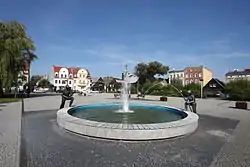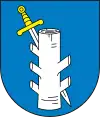Rakoniewice
Rakoniewice [rakɔɲɛˈvʲit͡sɛ] (German: Rakwitz) is a town in Grodzisk Wielkopolski County, Greater Poland Voivodeship, Poland, with 3,576 inhabitants (2006).
Rakoniewice | |
|---|---|
 Fountain at the town square | |
 Flag  Coat of arms | |
 Rakoniewice | |
| Coordinates: 52°8′27″N 16°16′23″E | |
| Country | |
| Voivodeship | Greater Poland |
| County | Grodzisk Wielkopolski |
| Gmina | Rakoniewice |
| Area | |
| • Total | 3.4 km2 (1.3 sq mi) |
| Population (2006) | |
| • Total | 3,253 |
| • Density | 960/km2 (2,500/sq mi) |
| Postal code | 62-067 |
| Website | http://www.rakoniewice.pl/ |
History
The settlement was recorded in 1252 and named after the komes of Greater Poland, Rakoń. It received city rights in 1662 through the efforts of voyevoda of Poznań Krzysztof Grzymułtowski.
Rakoniewice in the 17th century was associated with the settlement of so-called dissenters who favored property owners. The city became a center of crafts.
In the years 1869-1872 Robert Koch, a German microbiologist and later Nobel laureate, conducted his first medical practice in the town, then part of Germany and known by its German name, Rakwitz.
In the years 1901 - 1906 the town, was the scene of school strikes. In 1919, after World War I, the town became part of Poland. Until 1975 was part of a municipality Rakoniewice Wolsztyn county.
In 1975-1998 belonged to the province Poznań.
Despite the historical, geographical, economic reasons to merge with the reconstituted municipality in 1999 wolsztyńskim district and opposition of local residents of the villages for a better location for Wolsztyn, Rakoniewice joined the county Grodzisk.
Sights
- Timbered church from the 18th century, now Greater Fire Service Museum
- Arcaded houses from the 18th - 19th century
- Eclectic palace from the 19th century
Transport
Through the city runs the national road No. 32 Stęszew - Wolsztyn - Zielona Góra - Gubin and the railway line No 357 Wolsztyn - Grodzisk Wielkopolski - Lubon near Poznań - Poznań.